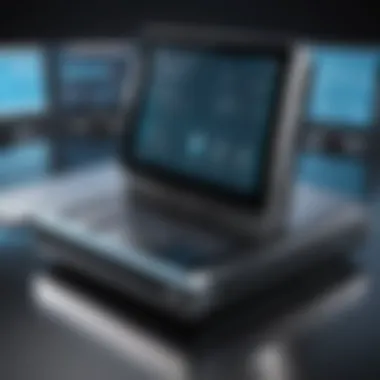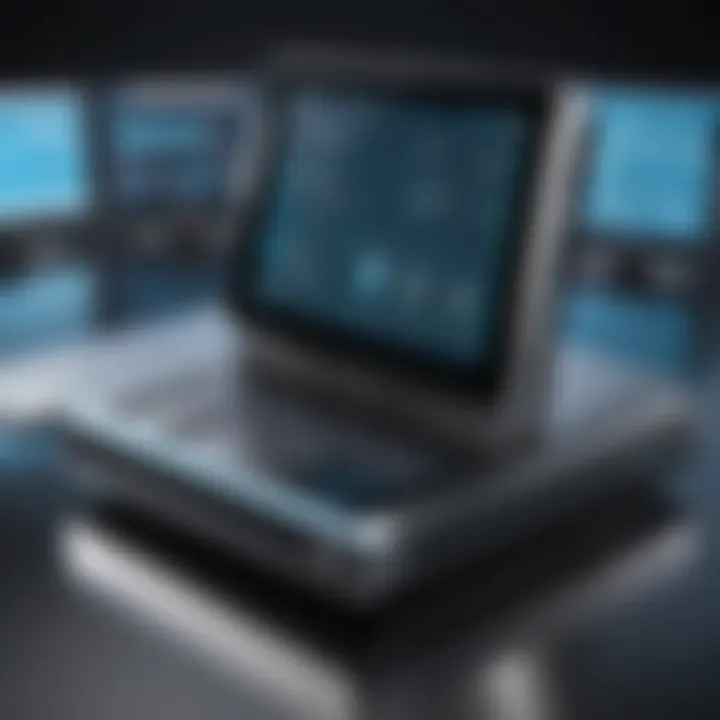Exploring the 2Touch POS System: A Comprehensive Guide


Intro
The 2Touch POS System is becoming a significant player in the world of point-of-sale technology. As businesses grapple with the fast-paced demand for efficiency and customer satisfaction, having a reliable POS system can make a huge difference. This article takes an in-depth look at what the 2Touch system offers, from its essential features to its pricing structures, aiming to equip decision-makers and industry professionals with the knowledge they need.
In this guide, we will explore the operational frameworks that make 2Touch stand out. We'll dive into how it streamlines transactions, enhances user experiences, and integrates effectively with existing systems. By the end, you will have a solid grasp of this system's place in today’s digital marketplace, helping you determine if it's the right fit for your business needs.
Key Features and Functionalities
Comprehensive Overview
At its core, the 2Touch POS System is designed with versatility in mind. One key feature is its ability to cater to various sectors such as retail, hospitality, and services. The software includes functionalities like inventory management, sales tracking, and customer relationship management, all wrapped in an intuitive user interface. This isn't just another software; it's a comprehensive tool that seeks to simplify complex business processes.
- User-Friendly Interface: Designed for ease, even those less tech-savvy can manage transactions smoothly.
- Real-Time Data Access: Offers immediate insight into sales trends and inventory levels, allowing businesses to make informed decisions.
- Mobile Compatibility: The system supports mobile devices, enabling sales transactions on the go, perfect for vendors attending events or trades.
Target Users
The 2Touch system isn’t restricted to just one niche. It appeals to a diverse array of businesses:
- Retail Stores: Whether it’s a small boutique or a larger chain, the need for efficient transaction management is universal.
- Restaurants and Cafes: Quick service and table management features are essential in this fast-paced environment.
- Service Providers: Gyms, salons, and various service-based businesses benefit greatly from scheduling and transaction functionalities.
As a multipurpose platform, it's crucial for users to understand how the system aligns with their specific operational needs.
Pricing Models and Cost Analysis
Breakdown of Pricing Tiers
Investing in a POS system is no small decision, and with 2Touch, understanding the costs involved is essential. The pricing structure often varies based on the features selected and the number of locations:
- Basic Plan: Offers fundamental functionalities at a lower monthly cost, ideal for small businesses just getting started.
- Premium Plan: Designed for larger establishments needing advanced features, including custom reporting and multi-location support.
Additional Costs to Consider
While the base price gives a decent indicator, there may be extra fees worth noting:
- Setup Costs: Initial installation and integration into existing systems can add to the budget.
- Training Fees: Depending on how extensive the training, it can become a hidden cost that users need to prepare for.
- Ongoing Maintenance: Subscriptions often include regular updates, but be aware of any maintenance fees that could pop up down the line.
Understanding the complete cost spectrum of the 2Touch POS system ensures that businesses can budget effectively and avoid surprises.
"A robust POS system can turn your business into a well-oiled machine, making every sales transaction a seamless experience for both the team and the customer."
In summary, the 2Touch POS System claims its spot in the market with its unique features and usability. For businesses looking to elevate their operational efficiency and customer experience, 2Touch offers a promising solution.
Intro to 2Touch POS
In the ever-evolving landscape of commerce, the importance of an efficient Point of Sale (POS) system cannot be overstated. The 2Touch POS System stands out as a significant player, offering various features that cater to the diverse needs of businesses. Understanding this system is essential not only for decision-makers but also for IT professionals and entrepreneurs looking to enhance their operations.
Overview of Point of Sale Systems
Point of Sale systems have come a long way from the traditional cash registers of yesteryears. Nowadays, a sophisticated POS is vital for managing sales transactions, inventory, and customer interactions seamlessly. They allow businesses to track every sale, manage stock levels, and analyze customer buying patterns.
These systems are no longer just a means of processing transactions; they are integral to operational strategy. A POS system that is capable of providing insights into sales performance, streamlining customer service, and integrating with other business applications can give companies a competitive edge.
Key aspects of a modern POS system include:
- Transaction Processing: Quick, reliable, and secure methods for handling payments.
- Inventory Management: Real-time inventory tracking to avoid stockouts and overstocking.
- Customer Relationship Management: Tools for loyalty programs and collecting customer feedback to enhance service.
In this context, examining the specific capabilities of 2Touch POS offers a clearer picture of how it adds value to various industry sectors.
What Makes 2Touch Unique?
2Touch POS sets itself apart from many other systems in the market with its intuitive design and extensive functionality. Several aspects contribute to its unique standing:
- User-Friendliness: At the heart of the 2Touch system is a user-friendly interface designed to minimize the learning curve for employees. This simplicity in design enables better engagement, which translates to enhanced customer service and efficiency.
- Customization Options: Different businesses have varied operational needs. 2Touch allows significant customization to match specific requirements, whether in retail environments or hospitality.
- Robust Customer Support: The technical support provided by 2Touch is noteworthy. Users get access to a team ready to assist, ensuring that potential issues are resolved quickly to avoid disruption in service.
- Data Security: In an era where data breaches happen often, 2Touch emphasizes security, ensuring that transactions are processed securely and customer data is protected.
In summary, diving into the 2Touch POS System provides insights beyond mere functionalities; it embodies how a well-designed system can fundamentally improve business operations, streamline workflows, and enhance the overall customer experience.
Core Features of 2Touch POS


Understanding the core features of the 2Touch POS system is essential for decision-makers and industry professionals looking to enhance their operational efficiencies. These features serve as the backbone of any robust POS solution, allowing users not only to process payments but also to manage various aspects of their business seamlessly. Let’s dive into what makes 2Touch palpably effective in a competitive landscape.
User Interface and Experience
The user interface of any POS system can make or break the user experience. With 2Touch, simplicity meets functionality. The layout is designed with an intuitive approach in mind, ensuring that employees can navigate effortlessly through the various functionalities.
- The dashboard presents key metrics at a glance, helping staff pinpoint areas that deserve immediate attention.
- Color-coded categories allow for rapid recognition of sales items, which is especially useful during busy service hours.
- Touchscreen responsiveness feels natural, almost as if it's second nature for the user, enhancing speed and reducing time spent on transactions.
In today’s digital age, a pleasant user experience translates directly to improved customer satisfaction. The easier it is for your team to use the system, the faster they can serve your customers.
Inventory Management
Inventory management can often feel like walking a tightrope without a safety net. But with 2Touch, businesses can put worries aside as they gain a clear hold on their stock. This system offers a plethora of tools that keep inventory levels optimal and helps avoid stockouts or overstock situations.
- Real-time tracking: Know instantly what products are flying off the shelves and which ones are gathering dust.
- Automated alerts: Set thresholds for low stock levels so that you never lose a sale due to empty shelves.
- Integrative capabilities: 2Touch can connect with your supply chain management software, creating a smooth flow of information from purchase orders to sales reports.
With these features, 2Touch not only assists in maintaining stock levels but also liberates valuable time for managers who can then maneuver their focus towards strategic goals instead of micromanaging inventory.
Sales Tracking and Reporting
Sales are the lifeblood of any business, and 2Touch offers robust mechanisms for tracking and analyzing sales data. Accurate sales tracking can unveil trends that might otherwise go unnoticed, thus guiding business strategies moving forward.
- Daily summaries: Receive concise reports at the end of the day highlighting the best-performing products and employees.
- Customer behavior analysis: Understand what your customers are buying and when. This insight can help tailor marketing efforts and promotions effectively.
- Integrated analytics tools: Leverage data within the system to foresee sales patterns and tweak inventory accordingly.
This level of reporting empowers organizations to not just react to sales but to proactively shape their sales strategies.
Customer Relationship Management
No successful business can afford to overlook the significance of customer relationships. 2Touch includes integrated CRM features that allow businesses to build and sustain strong connections with their customers.
- Loyalty programs: Customizable programs to reward repeat customers foster retention and higher lifetime value.
- Customer profiles: Access detailed profiles that show purchase history, preferences, and feedback, enabling personalized service that can delight and surprise patrons.
- Feedback loops: Tools to solicit customer feedback directly through the POS system allow companies to adapt swiftly to customer needs.
In essence, 2Touch helps businesses not just serve customers, but understand them deeply—a key element in today’s market where personal touch is rare.
By integrating user-friendly features with essential business tools, 2Touch POS stands out as a well-rounded system to elevate operational effectiveness.
The core features of the 2Touch POS system reveal its design focus on practicality and innovation. These capabilities are crucial to enhancing day-to-day operations, allowing businesses to handle sales, manage inventory, and engage customers—all within a single platform.
Integration Capabilities
In the fast-paced landscape of commerce today, the role of integration capabilities in a Point of Sale system cannot be overstated. Businesses are not operating in silos anymore. They require systems that can seamlessly communicate with one another to ensure a fluid exchange of information. This is where the 2Touch POS system shines. Having the ability to sync data with other applications means organizations can streamline operations, enhance productivity, and ultimately provide a better customer experience.
Compatibility with Other Software
2Touch POS is designed with compatibility in mind. It can easily integrate with numerous other software solutions, such as accounting platforms like QuickBooks or CRM tools like Salesforce. This not only saves time but also reduces the risk of human error often associated with manual data transfer. The real magic happens when business managers can view sales figures and customer data in real-time without having to shuffle between multiple software. Here are some benefits of this compatibility:
- Time-Saving: Automated data updates mean less manual entry.
- Real-Time Analytics: Instant access to valuable insights helps in better decision-making.
- Improved Workflow: Integrating orders and inventory management reduces delays in service.
"In today’s chaotic market, interoperability isn’t just a benefit; it’s a necessity."
APIs and Third-Party Solutions
Another cornerstone of the 2Touch POS system is its API (Application Programming Interface) capabilities. These APIs allow the system to connect with various third-party solutions effortlessly. This aspect opens a treasure trove of possibilities for businesses.
For instance, e-commerce platforms can easily link with physical stores. Imagine a scenario where an online customer completes a purchase; the inventory is automatically updated in the 2Touch POS system, reflecting current stock levels in real-time. Here’s why this is key:
- Enhanced Flexibility: Businesses can customize the system based on their unique needs and workflows.
- Extensive Ecosystem: With a plethora of third-party applications available, businesses can choose tools that best suit their requirements.
- Cost-Efficiency: Plugging existing systems into 2Touch POS reduces the need for complete system overhauls, saving money in the long run.
In summary, the integration capabilities of the 2Touch POS system are fundamental for modern businesses. They facilitate not just better operations but also a more coherent customer experience. Ensuring your system can communicate with others effectively can lead to unparalleled efficiency and growth.
Benefits of Using 2Touch POS
When considering a point of sale system, it's crucial to understand how it can influence your business operations. The 2Touch POS system offers several compelling advantages that can drive growth and efficiency in various sectors. From retail to hospitality, businesses are discovering the transformative potential of this technology. Let's dive deeper into some of the key benefits that 2Touch brings to the table.
Streamlining Operations
One of the standout features of the 2Touch POS system is its ability to streamline operations. For businesses, particularly those that juggle multiple tasks daily, reducing complexities can spell the difference between success and chaos.


Think about a bustling restaurant during the dinner rush. The staff is busy, orders are flying in, and the last thing they need is a complicated system. That’s where 2Touch shines. Its user-friendly interface allows for quick order entry and processing, minimizing wait times and errors. Employees can focus more on customer service rather than struggling with tech. This efficiency not only enhances the operational flow but also increases overall productivity.
- Multi-Functionality: 2Touch supports various payment methods including credit cards, mobile wallets, and loyalty programs, creating a convenient experience for customers.
- Real-Time Inventory Updates: As products are sold, inventory levels adjust immediately. This prevents stockouts and lets managers reorder effectively.
In short, 2Touch simplifies operations, meaning your team can do more with less hassle.
Enhancing Customer Engagement
In today's competitive market, customer engagement has become paramount. 2Touch POS brings a treasure trove of features that foster engagement and improve customer satisfaction. The system supports personalized experiences through loyalty programs, enabling businesses to tailor promotions based on purchase history.
When customers feel valued, they’re more likely to return. By using the data collected through 2Touch, businesses can identify patterns and preferences, informing marketing strategies that resonate. This ensures that the right message reaches the right person at the right time.
"Customer engagement is not just a trend; it's a necessity for growth."
Moreover, with POS-integrated feedback systems, businesses can gather insights directly from customers.
- Flexible Payment Options: Customers today expect to pay in various ways. With 2Touch, offering options such as contactless payments can significantly enhance the shopping experience.
- Mobile Integration: Customers can browse menus or product catalogs on their phones. This encourages interaction and keeps them connected to the business even after they leave.
Cost Efficiency and Scalability
The reality of business is that costs can spiral if not monitored effectively. 2Touch POS is designed with cost-efficiency in mind. By integrating multiple functionalities into a single platform, businesses can reduce costs associated with operating multiple systems.
For instance, inventory management, reporting, and customer engagement tools all come together in one interface, lessening the need for additional software subscriptions.
But it doesn't stop there. Scalability is another strong suit. As businesses grow, their systems should grow with them. 2Touch POS can adapt to various business sizes and types, making it an ideal choice for both small startups and large enterprises.
- Affordable Pricing Plans: The flexibility in pricing allows businesses to select a plan that meets their needs without breaking the bank.
- Easy Onboarding: Businesses can start small, gradually taking advantage of advanced features as they expand, ensuring that the switch to a new system is not a financial burden.
In summary, 2Touch POS offers a multitude of benefits that can elevate operations, enhance engagement, and ensure cost effectiveness, paving the way for sustained growth and success in a highly competitive landscape.
Case Studies and User Experiences
Understanding how a system like 2Touch POS truly impacts businesses can often be gleaned from real-world applications. Case studies provide invaluable insights that go beyond mere functionality; they showcase the direct effects on efficiency, customer service, and overall performance in diverse sectors. By examining these case studies, decision-makers can weigh the effectiveness of 2Touch POS in their unique context. Here, we will explore insights from the retail sector and hospitality industry, emphasizing the tangible benefits and considerations that come with implementing this POS system.
Retail Sector Insights
In the retail world, the Point of Sale system often does more than just handle transactions. For instance, a mid-size apparel store in Boston adopted the 2Touch POS system to overhaul its clunky cash register setup. This store faced issues such as lagging transaction times during peak hours and inadequate inventory tracking. After switching to 2Touch, they saw an impressive reduction in wait times, allowing staff to cater to customers with more focus.
The POS system enabled real-time inventory management, so stock levels could be constantly updated. This not only made it easier to avoid stockouts but also allowed the store to offer better service during sales events. Customers appreciated the seamless checkout experience, leading to increased repeat visits.
Some notable outcomes included:
- Decrease in customer complaints: After implementation, the store noted a 30% drop in negative feedback, primarily related to long wait times.
- Improved sales tracking: The analytics features helped management pinpoint which products were underperforming, allowing for informed adjustments in merchandising.
- Enhanced employee efficiency: With an intuitive interface, cashiers adapted quickly, reducing training time significantly.
Hospitality Industry Applications
In the bustling hospitality sector, a boutique hotel chain in Miami implemented 2Touch POS to enhance guest experience, which was a top priority for them. Their existing system struggled with managing both food services and room orders, leading to inaccuracies and delays. After switching to the 2Touch system, the hotel reported that communication between kitchen and service staff vastly improved.
The POS system also facilitated better customer engagement, allowing menu items to be updated in real-time based on inventory, thus ensuring that guests were informed about availability. Through the integration of customer profiles, the hotel could also recommend favorite dishes or drinks. Some key takeaways included:
- Improved order accuracy: The direct table-side ordering feature cut down on miscommunication, leading to a 25% decline in order-related complaints.
- Increased revenue per guest: Since guests had access to tailored promotions through the system, upsells became more effective, boosting the average revenue from food and beverages.
- Streamlined employee operations: Staff turnover can be high in hospitality, so with a user-friendly system, new employees got up to speed quickly, reducing downtime during busy shifts.
"The right POS system goes beyond numbers; it facilitates connections, enhances experiences, and drives business growth."
Through these case studies, it’s clear that the 2Touch POS system serves as more than just a transaction processor. It can dramatically reshape operations, improve user experiences, and foster better customer relations across diverse industries. Understanding how a system performs in various environments enables businesses to make informed decisions about integrating technology that aligns with their goals.
Challenges and Limitations
Understanding the challenges and limitations associated with the 2Touch POS system is crucial for potential users aiming to make informed decisions. While 2Touch POS offers robust functionalities, it’s not devoid of hurdles. Recognizing these drawbacks allows stakeholders to manage expectations and prepare adequately, ensuring a smoother implementation into their business operations.
Technical Drawbacks
Despite its myriad features, 2Touch POS does have certain technical shortcomings that might pose issues for users. One primary concern revolves around connectivity. For instance, in areas with weak internet coverage, the system may experience disruptions, which can lead to delayed transaction processes. This unavailability can be detrimental, particularly in fast-paced retail or hospitality environments where every second counts.
Another notable technical drawback is the occasional software bugs that pop up. Users sometimes encounter glitches during operations, making transactions less efficient. Such hiccups often require timely patches and updates from the developers, which can be inconvenient and may affect business flow.
Moreover, hardware limitations can also create a bottleneck. Not all legacy systems integrate seamlessly with 2Touch POS, occasionally forcing businesses to invest in new hardware. This adds an unexpected cost that can be a tough pill to swallow for small or mid-sized businesses.


User Training Requirements
Implementing a sophisticated system like 2Touch POS necessitates a certain degree of user training. Although the interface is designed to be intuitive, it still requires time for staff to become familiar with its functionalities. Users often find themselves needing substantial guidance to navigate through some features effectively, especially if they’ve previously been accustomed to simpler systems.
This can result in steep learning curves, particularly in businesses where new employees join frequently or where staff turnover is high. For businesses investing in 2Touch, allocating resources for comprehensive training sessions is not just a recommendation; it’s a necessity.
Training sessions can also become a challenge in terms of time management. Scheduling hours for training can disrupt regular operations, leading to a loss of productivity. Some teams may resist changing their established workflows, heightening the importance of effective change management strategies.
Always remember, the initial investment in training can translate to smoother operations and a better return in the long run.
Comparative Analysis with Other POS Systems
In the ever-evolving realm of technology, comparing different Point of Sale systems is paramount for businesses aiming to optimize their operations. The 2Touch POS system might stand out in its own right, but the competition is stiff. Thus, undertaking a comparative analysis allows stakeholders to make informed decisions that go beyond surface-level features.
Recognizing how 2Touch positions itself within the marketplace helps in evaluating its suitability for specific business needs. It’s not just about picking the flashiest option; it’s about finding what aligns with a company's operational model, customer base, and budget criteria. Other systems may offer different strengths, and understanding these nuances is critical for decision-makers who seek value-added solutions.
"A smart buyer isn't just looking for a shiny tool; they're looking for a partner in productivity."
Market Positioning
Market positioning plays a significant role in how customers perceive a POS system like 2Touch. This system is not merely a transactional tool; it's designed with a clear focus on both retail and hospitality sectors. By analyzing where 2Touch sits in relation to its competitors, we can glean insights into its target users and industry appropriateness.
Key elements to consider in market positioning include:
- Target Audience: 2Touch primarily caters to medium to large businesses. If a company operates on a larger scale, 2Touch may offer the customization and integrations that simpler systems lack, making it a more attractive option.
- Geographic Reach: Competing solutions may have different strengths in local or international markets. If a business aims to expand internationally, understanding how well a point of sale system integrates with various currencies and tax regulations is necessary.
- Brand Reputation: The trust and recognition a brand carries can greatly influence customer choice. Users may prefer tried and tested systems over newer entrants that don’t have a track record.
Feature-by-Feature Comparison
A feature-by-feature comparison sheds light on exactly what makes 2Touch POS distinctive or comparable to its rivals. Here's a breakdown that dives into specific features where 2Touch excels or falls short in the broader market:
- User Interface: While 2Touch is known for its user-friendly interface, some other systems like Square or Toast may present a more streamlined experience for new users.
- Inventory Management: 2Touch offers robust inventory tracking but could benefit from advanced predictive analytics which some competitors provide.
- Customer Relationship Management: The built-in CRM of 2Touch is useful, but other systems may offer more features that enhance customer engagement through personalized communication.
- Integration Capabilities: Though 2Touch supports many third-party applications, it’s wise to scrutinize how seamless these integrations are when compared to systems like Vend or Clover, which may boast more extensive partnership ecosystems.
Future Developments and Innovations
The landscape of Point of Sale systems is continually evolving, and the 2Touch POS system is no exception. Future developments and innovations in this domain are pivotal not just for maintaining competitiveness, but also for enhancing functionality and user experience. Given the rapid pace of technological change, companies need to stay ahead of trends to harness the full potential of their systems. By understanding anticipated upgrades and key trends in POS technology, businesses can make informed decisions and adapt to the ever-changing environment of retail and hospitality.
Anticipated Upgrades
As with many technology platforms, the 2Touch POS system is expected to see upgrades that respond to both consumer demands and technological enhancements. Some anticipated upgrades include:
- Enhanced Integration: As businesses increasingly rely on various software solutions, the ability for 2Touch POS to integrate seamlessly with third-party applications will be a game changer. Expect enhancements in API capabilities that will allow for more robust data transfer and automation between systems.
- AI and Machine Learning: Future versions of 2Touch are likely to incorporate AI and machine learning features. This could leverage customer purchase history, enabling personalized marketing strategies and tailored promotions. As a result, businesses can enhance customer loyalty and boost sales.
- Mobile Functionality: Upgrades may also focus on improving mobile capabilities. With the rise of mobile commerce, updating the POS system for better mobile optimization can greatly enhance user experience. This can involve a more responsive design and improved mobile payment options.
"To stay competitive, businesses must adapt to new technologies, or risk falling behind their tech-savvy rivals."
Each of these anticipated upgrades presents opportunities for businesses to optimize their operations and enhance overall efficiency.
Trends in POS Technology
Keeping abreast of trends in POS technology is crucial for decision-makers and IT professionals alike. Here are some notable trends that are shaping the future of the industry:
- Cloud-Based Solutions: The shift to cloud-based POS systems is rapidly gaining traction. This trend offers the benefits of real-time data access, reduced hardware costs, and enhanced security features. 2Touch is likely to implement more cloud functionalities to ensure rapid data retrieval and backup.
- Omnichannel Integration: The blending of various sales channels, including online and offline, is becoming increasingly important. Consumers expect a unified experience regardless of how they engage with a business. Effective omnichannel integration in the 2Touch POS will allow retailers to track inventory and sales across platforms, providing a holistic view of customer interactions.
- Contactless Payments: With the ongoing global focus on health and safety, the demand for contactless payment systems will only increase. Innovations in NFC technology and mobile wallets will need to be addressed in future iterations of 2Touch POS.
By embracing these trends, businesses can ensure their operations remain flexible, efficient, and geared towards enhanced customer satisfaction.
Ending
The conclusion of this article offers more than just a neat bow on the discussion of the 2Touch POS system; it serves as a vital reminder of the myriad ways such systems can influence business operations. Understanding the specifics of the 2Touch system includes reflecting on its core attributes, its potential for multi-sector versatility, and its role in enhancing customer interactions. For decision-makers, the insights gleaned here can significantly impact future tech investments.
Recap of Key Points
The journey through this article laid out several cornerstone findings important for buyers and tech enthusiasts alike. Let's revisit them:
- User Experience is paramount: The design and functionality of 2Touch make it accessible, which is crucial in busy environments.
- Integration Flexibility: The ability to connect with other software allows businesses to maintain a streamlined workflow, reducing friction.
- Comprehensive Reporting: Sales tracking features not only inform about past performance but also aid in forecasting and strategic planning.
- Scalability: Whether it's a small shop or a larger enterprise, 2Touch can adapt as a business grows, making it cost-effective in the long run.
- Customer Centricity: Particularly in the hospitality industry, enhancing customer interactions is essential, and 2Touch is equipped to facilitate this.
In sum, these elements contribute to a holistic understanding of how the 2Touch POS can be tailored to meet diverse operational needs across multiple sectors.
Deciding on 2Touch POS
As we bring this discussion to a close, the decision-making process on implementing 2Touch can hinge on multiple considerations:
- Business Needs Assessment: Evaluate specific requirements against what 2Touch offers. Does it align with your operational priorities?
- Cost Implications: Assess both initial investment and ongoing costs against your budget. A thorough cost-benefit analysis is crucial.
- Future Growth: Think critically about long-term scalability. Is the system built to grow along with your enterprise's ambitions?
- User Adaptability: Consider the technical skills of your staff. Will they require extensive training to navigate the new system effectively?
Making an informed decision will mean weighing these factors carefully, ensuring that the chosen POS system meets both current and future requirements of your business. The potential benefits are substantial, but careful consideration will ensure they are fully realized.















